Jack18cubes
On this page, you find all documents, package deals, and flashcards offered by seller jack18cubes.
- 28
- 0
- 0
Community
- Followers
- Following
28 items
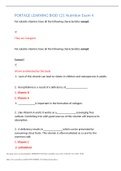
PORTAGE LEARNING BIOD 121 Nutrition Exam 4
PORTAGE LEARNING BIOD 121 Nutrition Exam 4 Fat soluble vitamins have all the following characteristics except: They are inorganic Fat soluble vitamins have all the following characteristics except: Correct! All are synthesized by the body 1. Lack of this vitamin can lead to rickets in children and osteoporosis in adults. 2. Xeropthalmia is a result of a deficiency of . 1. Vitamin D 2. Vitamin A 1. is important in the formation of collagen. 2. Like Vitamin A...
- Exam (elaborations)
- • 4 pages •
PORTAGE LEARNING BIOD 121 Nutrition Exam 4 Fat soluble vitamins have all the following characteristics except: They are inorganic Fat soluble vitamins have all the following characteristics except: Correct! All are synthesized by the body 1. Lack of this vitamin can lead to rickets in children and osteoporosis in adults. 2. Xeropthalmia is a result of a deficiency of . 1. Vitamin D 2. Vitamin A 1. is important in the formation of collagen. 2. Like Vitamin A...
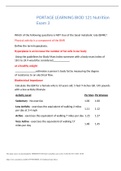
PORTAGE LEARNING BIOD 121 Nutrition Exam 3
PORTAGE LEARNING BIOD 121 Nutrition Exam 3 Which of the following questions is NOT true of the basal metabolic rate (BMR)? Physical activity is a component of the BMR Define the term hyperplasia. Hyperplasia is an increase the number of fat cells in our body Using the guidelines for Body Mass Index someone with a body mass index of 18.5 to 24.9 would be considered . at a healthy weight estimates a person’s body fat by measuring the degree of resistance to an electrical flow. Bioele...
- Exam (elaborations)
- • 5 pages •
PORTAGE LEARNING BIOD 121 Nutrition Exam 3 Which of the following questions is NOT true of the basal metabolic rate (BMR)? Physical activity is a component of the BMR Define the term hyperplasia. Hyperplasia is an increase the number of fat cells in our body Using the guidelines for Body Mass Index someone with a body mass index of 18.5 to 24.9 would be considered . at a healthy weight estimates a person’s body fat by measuring the degree of resistance to an electrical flow. Bioele...
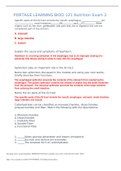
PORTAGE LEARNING BIOD 121 Nutrition Exam 2
PORTAGE LEARNING BIOD 121 Nutrition Exam 2 Specific parts of the GI tract include the mouth, esophagus, (A) , small intestine, (B) and (C) . Other organs such as the liver, gallbladder and pancreas aid in digestion but are not considered part of the GI tract. A. stomach B. large intestine C. rectum Explain the cause and symptoms of heartburn. Heartburn is a burning sensation in the esophagus due to an improper closing of a sphincter that allows stomach acids to enter into the esophagu...
- Exam (elaborations)
- • 3 pages •
PORTAGE LEARNING BIOD 121 Nutrition Exam 2 Specific parts of the GI tract include the mouth, esophagus, (A) , small intestine, (B) and (C) . Other organs such as the liver, gallbladder and pancreas aid in digestion but are not considered part of the GI tract. A. stomach B. large intestine C. rectum Explain the cause and symptoms of heartburn. Heartburn is a burning sensation in the esophagus due to an improper closing of a sphincter that allows stomach acids to enter into the esophagu...
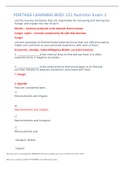
PORTAGE LEARNING BIOD 121 Nutrition Exam 1
PORTAGE LEARNING BIOD 121 Nutrition Exam 1 List the two key hormones that are responsible for increasing and decreasing hunger and explain the role of each. Gherlin – hormone produced in the stomach that increases hunger. Leptin – hormone produced by fat cells that decrease hunger. List two examples of Environmental external forces that can influence eating habits and comment on your personal experience with each of them. Economics, Lifestyle, Cultural/Religious Beliefs, Local Environmen...
- Exam (elaborations)
- • 5 pages •
PORTAGE LEARNING BIOD 121 Nutrition Exam 1 List the two key hormones that are responsible for increasing and decreasing hunger and explain the role of each. Gherlin – hormone produced in the stomach that increases hunger. Leptin – hormone produced by fat cells that decrease hunger. List two examples of Environmental external forces that can influence eating habits and comment on your personal experience with each of them. Economics, Lifestyle, Cultural/Religious Beliefs, Local Environmen...
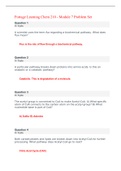
Portage Learning Chem 210 - Module 7 Problem Set
Portage Learning Chem 210 - Module 7 Problem Set A scientist uses the term flux regarding a biochemical pathway. What does flux mean? Flux is the rate of flow through a biochemical pathway. A particular pathway breaks down proteins into amino acids. Is this an anabolic or a catabolic pathway? Catabolic. This is degradation of a molecule. The acetyl group is connected to CoA to make Acetyl-CoA. A) What specific atom of CoA connects to the carbon atom on the...
- Exam (elaborations)
- • 10 pages •
Portage Learning Chem 210 - Module 7 Problem Set A scientist uses the term flux regarding a biochemical pathway. What does flux mean? Flux is the rate of flow through a biochemical pathway. A particular pathway breaks down proteins into amino acids. Is this an anabolic or a catabolic pathway? Catabolic. This is degradation of a molecule. The acetyl group is connected to CoA to make Acetyl-CoA. A) What specific atom of CoA connects to the carbon atom on the...
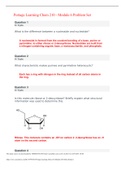
Portage Learning Chem 210 - Module 6 Problem Set
Portage Learning Chem 210 - Module 6 Problem Set What is the difference between a nucleoside and nucleotide? A nucleoside is formed from the covalent bonding of a base, purine or pyrimidine, to either ribose or 2-deoxyribose. Nucleotides are built from a nitrogen-containing organic base, a monosaccharide, and phosphate. What characteristic makes purines and pyrimidine heterocyclic? Each has a ring with nitrogen in the ring instead of all carbon atoms in the ring. ...
- Exam (elaborations)
- • 5 pages •
Portage Learning Chem 210 - Module 6 Problem Set What is the difference between a nucleoside and nucleotide? A nucleoside is formed from the covalent bonding of a base, purine or pyrimidine, to either ribose or 2-deoxyribose. Nucleotides are built from a nitrogen-containing organic base, a monosaccharide, and phosphate. What characteristic makes purines and pyrimidine heterocyclic? Each has a ring with nitrogen in the ring instead of all carbon atoms in the ring. ...

Portage Learning Chem 210 - Module 3 exam
Portage Learning Chem 210 - Module 3 exam True or False: The amino acids serine and threonine both contain sulfur atoms. FALSE True or False: The following secondary structure shown below is an example of a beta- turn. FALSE True or False. The side chain of phenylalanine is bonded to the backbone nitrogen atom. FALSE True or False: The name of the molecule that binds to an enzyme is called the holoenzyme. FALSE True or False: An inhibitor ...
- Exam (elaborations)
- • 16 pages •
Portage Learning Chem 210 - Module 3 exam True or False: The amino acids serine and threonine both contain sulfur atoms. FALSE True or False: The following secondary structure shown below is an example of a beta- turn. FALSE True or False. The side chain of phenylalanine is bonded to the backbone nitrogen atom. FALSE True or False: The name of the molecule that binds to an enzyme is called the holoenzyme. FALSE True or False: An inhibitor ...

Portage Learning Chem 210 - Module 3 exam
Portage Learning Chem 210 - Module 3 exam True or False: The amino acids serine and threonine both contain sulfur atoms. FALSE True or False: The following secondary structure shown below is an example of a beta- turn. FALSE True or False. The side chain of phenylalanine is bonded to the backbone nitrogen atom. FALSE True or False: The name of the molecule that binds to an enzyme is called the holoenzyme. FALSE True or False: An inhibitor ...
- Exam (elaborations)
- • 16 pages •
Portage Learning Chem 210 - Module 3 exam True or False: The amino acids serine and threonine both contain sulfur atoms. FALSE True or False: The following secondary structure shown below is an example of a beta- turn. FALSE True or False. The side chain of phenylalanine is bonded to the backbone nitrogen atom. FALSE True or False: The name of the molecule that binds to an enzyme is called the holoenzyme. FALSE True or False: An inhibitor ...
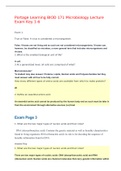
Portage Learning BIOD 171 Microbiology Lecture Exam Key 1-6
Portage Learning BIOD 171 Microbiology Lecture Exam Key 1-6 Exam 1. True or False: A virus is considered a microorganism. False. Viruses are not living and as such are not considered microorganisms. Viruses can, however, be classified as microbes, a more general term that includes microorganisms and viruses. 2. What is the smallest biological unit of life? A cell. 3. At a generalized level, all cells are comprised of what? Macromolecules* *A student may also answer: Proteins,...
- Exam (elaborations)
- • 34 pages •
Portage Learning BIOD 171 Microbiology Lecture Exam Key 1-6 Exam 1. True or False: A virus is considered a microorganism. False. Viruses are not living and as such are not considered microorganisms. Viruses can, however, be classified as microbes, a more general term that includes microorganisms and viruses. 2. What is the smallest biological unit of life? A cell. 3. At a generalized level, all cells are comprised of what? Macromolecules* *A student may also answer: Proteins,...
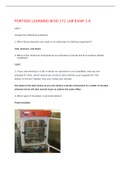
PORTAGE LEARNING BIOD 171 LAB EXAM 1-9
PORTAGE LEARNING BIOD 171 LAB EXAM 1-9 LAB 1 Answer the following questions 1. What three elements are used in an autoclave to sterilize equipment? heat, pressure, and steam 2. What is the minimum temperature an autoclave must be set at to achieve sterile condition? 125°C 3. If you are working in a lab in which an autoclave is not available, and you are pressed for time, which would you chose to best sterilize your equipment? Hot steam or hot air? Explain why you chose your...
- Exam (elaborations)
- • 23 pages •
PORTAGE LEARNING BIOD 171 LAB EXAM 1-9 LAB 1 Answer the following questions 1. What three elements are used in an autoclave to sterilize equipment? heat, pressure, and steam 2. What is the minimum temperature an autoclave must be set at to achieve sterile condition? 125°C 3. If you are working in a lab in which an autoclave is not available, and you are pressed for time, which would you chose to best sterilize your equipment? Hot steam or hot air? Explain why you chose your...
